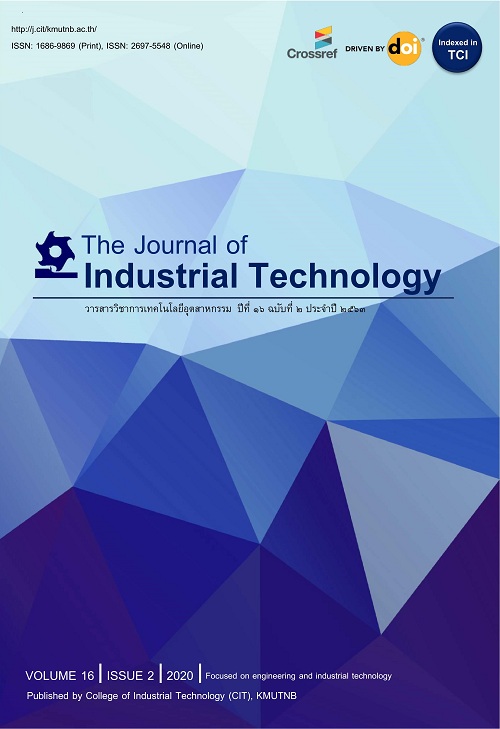A Study of the Freeze-Drying Process for Probiotics in Yogurt Produced from a Typical Household Freeze Dryer
การศึกษากระบวนการอบแห้งโพรไบโอติกในโยเกิร์ตโดยใช้เครื่องอบแห้งด้วยการแช่แข็งสำหรับใช้ในครัวเรือน
Abstract
การอบแห้งด้วยการแช่แข็งเป็นกระบวนการลดความชื้นในผลิตภัณฑ์ลงโดยกระบวนการเธอร์โมไดนามิกส์ที่ทำให้น้ำหรือสารละลายในอาหารถูกแช่แข็งแล้วทำให้ระเหิด ผลผลิตจากการการอบแห้งด้วยการแช่แข็งยังคงมีคุณภาพที่สูงเนื่องจากสามารถลดการเสื่อมสภาพและปฏิกิริยาทางจุลชีววิทยาของผลิตภัณฑ์ได้ดีกว่าเมื่อเปรียบเทียบกับผลผลิตที่ได้จากการอบแห้งด้วยเทคโนโลยีแบบอื่น ในการศึกษานี้เป็นการศึกษากระบวนการอบแห้งแบบแช่แข็งของโพรไบโอติกจากโยเกิร์ตในกระบวนการต่อเนื่องในเครื่องอบแห้งแบบแช่แข็งขนาดครัวเรือนที่การออกแบบและสร้างขึ้นสำหรับการแช่แข็งและอบแห้งในภาวะสุญญากาศ ใช้สารทำความเย็น R-410A เป็นสารทำความเย็นในกระบวนการทำความเย็นเพื่อแช่แข็ง มีวิสัยสามารถทำความเย็น 3 kW ในกระบวนการอบแห้ง โพรไบโอติกจากโยเกิร์ตมีอุณหภูมิกับดักความเย็น -40°C และอุณหภูมิผลิตภัณฑ์แช่แข็ง -20°C ในการทดลองได้วัตถุดิบโพรไบโอติกเหลวจากโยเกิร์ต 3000 g มาจัดวางบนถาดขนาด 250 mm × 400 mm × 20 mm จำนวน 6 ถาด บรรจุในห้องอบแห้งแบบแช่แข็ง ทำการวัดค่าอุณหภูมิ ความดัน วิเคราะห์วัฏจักรการทำความเย็น หาค่าสัมประสิทธิ์สมรรถนะทำความเย็น หาระยะเวลาในการแช่แข็งและเวลาในการแห้ง อัตราการอบแห้ง และค่าพลังงานไฟฟ้า รวมทั้งตรวจสอบเชื้อจุลินทรีย์จากการทดลองเพื่อพิจารณาผลของการรักษาคุณภาพของโพรไบโอติกก่อนและหลังการอบแห้งแบบแช่แข็งซึ่งพบว่าเชื้อจุลินทรีย์โพรไบโอติกหลังการอบแห้งแบบแช่แข็งยังคงมีมากเพียงพอต่อการบริโภคเพื่อด้านประโยชน์ต่อร่างกายมนุษย์
The freeze-drying process is a method to reduce moisture in products through a thermodynamics stage that involves freezing the water or solution in food, followed by sublimation. This process results in high-quality products as it effectively minimizes degradation and microbiological reactions compared to other drying technologies. The study focuses on the freeze-drying process of probiotics from yogurt in a continuous operation using an in-house, household-scale, freeze-dryer designed for vacuum freeze-drying. The refrigerant used is R-410A, with a cooling capacity of 3 kW, achieving a condenser temperature of -40°C and a product temperature of -20°C. In the experiment, 3000 g of liquid probiotic from yogurt was spread across six trays measuring 250 mm × 400 mm × 20 mm and dried in the freeze dryer. The study measured temperature, pressure, analyzed the refrigeration cycle, determined the coefficient of performance for cooling, freezing and drying times, drying rates, and electrical energy consumption. It also examined the microbiological content to assess the effect of freeze-drying on probiotic quality before and after drying. It found that the probiotic microorganisms remained sufficiently abundant post-drying for consumption with health benefits.
Keywords
[1] H. McGee et al., Fresh fermented milks and creams, in Food and Cooking: The Science and Lore of the Kitchen. New York, NY, USA: Scribner, 2004, 44-51.
[2] W.A.D.V. Weerathilake, D.M.D. Rasika, J.K.U Ruwanmali and M.A.D.D Munasinghe, The evolution, processing, varieties and health benefits of yogurt, International Journal of Scientific and Research Publication, 2014, 4(4), 1-10.
[3] Y. Karagül-Yüceer, J.C. Wilson and C. H. White, Formulations and processing of yogurt affect the microbial quality of carbonated yogurt, Journal of Dairy Science, 2001, 84(3), 543-550.
[4] H. Korbekandi, A.M. Mortazavian and S. Iravani, Technology and stability of probiotic in fermented milks, in probiotic and prebiotic foods: Technology, Stability and Benefits to the human health, N.P. Shah, Ed., Nova Science Publishing Ltd, NY, USA, 2011, 121-146.
[5] A.M. Mortazavian, R. Khosrokhavar, H. Rrastegar, and G.R. Mortazaei, Effects of dry matter standardization order on biochemical and microbiological characteristics of freshly made probiotic Doogh (Iranian fermented milk drink), Italian Journal of Food Science, 2010, 1(2), 98-104.
[6] A. Lourens-Hattingh and C.B. Viljoen, Yoghurt as a probiotic carrier food, International Dairy Journal, 2001, 11(1-2), 1-17.
[7] G. Perdigon, S. Alvarez, M. Rachid, G. Agüero, and N. Gobbato, Immune system stimulation by probiotics, Journal of Dairy Science, 1995, 78(7), 1597-1606.
[8] C.M. Galdeano and G. Perdigon, The probiotic bacterium Lactobacillus casei induces activation of the gut mucosal immune system through innate immunity, Clinical and Vaccine Immunology, 2006, 13(2), 219-226.
[9] J. Kiepś and R. Dembczyński, Current trends in the production of probiotic formulations, Foods, 2022, 11(15), 2330.
[10] N. Tyagi, Z. Gidlöf, D.T. Osanlóo, E.S. Collier, S. Kadekar, L. Ringstad, A.M. Fureby and S. Roos, The Impact of formulation and freeze drying on the properties and performance of freeze-dried limosilactobacillus reuteri R2LC, Applied Microbiology, 2023, 3(4), 1370-1387.
[11] L.-G. Ooi and M.-T. Liong, Cholesterol-lowering effects of probiotics and prebiotics: A review of in vivo and in vitro findings, International of Journal Molecular Sciences, 2010, 11(6), 2499–2522.
[12] L. Stratta, L.C. Capozzi, S. Franzino and R. Pisano, Economic analysis of a freeze-drying cycle, Processes, 2020, 8(11), 1399.
[13] T. Wasan, K. Triratanasirichai and K. Tangchaichit, Continuous production of lime juice by vacuum freeze drying, American Journal of Applied Sciences, 2008, 5(8), 959-962.
[14] T. Wasan, and K. Triratanasirichai, W., Air blast freezing of lime juice: Effect of processing parameters, American Journal of Engineering and Applied Sciences, 2008, 1(1), 33-39.
[15] I. Dinçer and M. Kanoglu, Refrigeration Systems and Applications, 2nd ED. Chichester, West Sussex, John Wiley & Sons, Ltd, UK, 2010.
[16] L.O.S. Buzelin, S.C. Amico, J.V.C. Vargas, and J.A.R. Parise, Experimental development of an intelligent refrigeration system, International Journal Refrigeration, 2005. 28(2), 165-175.
[17] R. Fuller, Probiotics in man and animals, Journal of Applied Bacteriology, 1989, 66(5), 365-378.
[18] Ministry of Public Health, The use of probiotic microorganisms, Royal Thai Government Gazette, 128(346), Special Section 86N, 2011. (in Thai)
[19] Ministry of Public Health, The use of probiotic microorganisms, 2Ed, Royal Thai Government Gazette, 129(346), Special Section 189N, 2012. (in Thai)
DOI: 10.14416/j.ind.tech.2024.08.010
Refbacks
- There are currently no refbacks.






